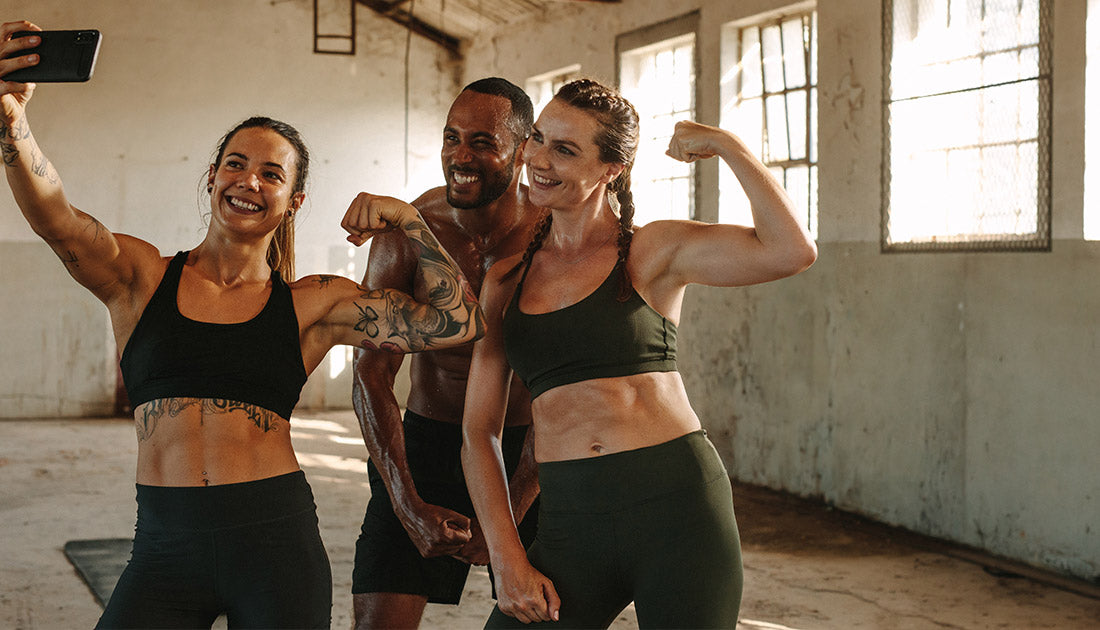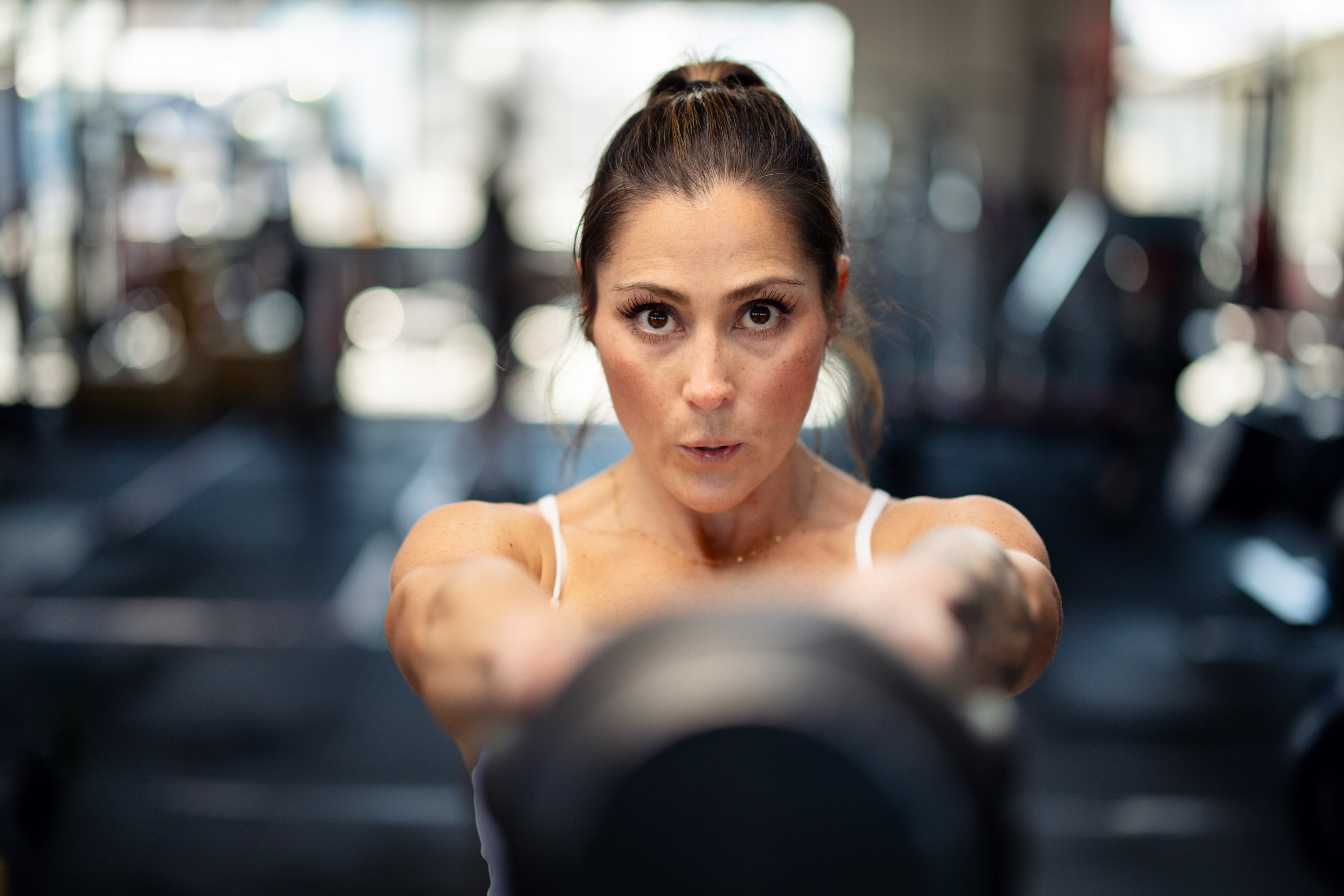Functional fitness has been a buzzword in the fitness industry for close to a decade. It remains a popular term, especially for gyms and group fitness classes looking to attract new clientele.
Perhaps you’ve heard of the term and wondered what functional fitness training is and if the type of workouts you’re doing qualify as “functional fitness.
Stick around and learn what functional fitness training is (and what it isn't) and some examples of functional fitness workouts.
Let’s get started!
What is Functional Fitness Training?
The term "functional fitness is thrown around a lot, but few individuals know what it means.
Simply put, functional fitness prepares you to perform certain functions better.
Where functional fitness has gone wrong in years past leads people to believe that to be "functional," they need to be doing squats on Bosu balls, kickbacks in a plank position or trying to lunge while curling pressing weights overhead.
Rest assured, there’s nothing really “functional” about these exercises, save for trying to gain notoriety and grow your social media channel.
Boiling things down to brass tacks, functional fitness training in the most rudimentary sense is training that will prepare you to thrive performing everyday movements -- getting off of the sofa, walking to the mailbox, picking stuff up off of the floor, pulling yourself up, etc.
Very rarely will you find yourself trying to balance on one leg while curling a dumbbell and then pressing it overhead, which is why most functional workouts you see on the internet are utter nonsense.
Now, it's essential to keep in mind that "functional" can mean different things for different people based on what goes on in their life. Some individuals live more sedentary lives while others live a more physically active life and/or work a more physically demanding job. With that in mind, two individuals can have very different "functional training" workouts.
Still, though, six-movement patterns are fundamental to all human beings and thus should be incorporated into any workout plan that considers itself functional fitness training.
Those six movement patterns are:
- Horizontal push (push-ups, bench press, dumbbell press, etc.)
- Vertical push (overhead press, military press, dips, etc.)
- Horizontal pull (rows of all kinds)
- Vertical pull (chin-ups, pull-ups, pulldowns, etc.)
- Squat (back squats, front squats, split squats, lunges)
- Hip hinge (deadlift, Romanian deadlift, stiff-legged deadlift)
As you can see, functional training overwhelmingly involves compound movements, which provide a tremendous muscle and strength-building “bang” for your exercise “buck.”
Gaining proficiency and strength in these core movement patterns will improve your physique as well as your day-to-day happenings. It also helped strengthen your resiliency and reduce the likelihood of injury.
Functional Fitness Workouts
Suitcase Squat (Deadlift)
The suitcase deadlift is a great old-school exercise to perform whether you're at the gym or even at home. It represents a hybrid between a squat and deadlift, more closely mimicking the setup you'd use for a trap bar (hex bar) deadlift.
Beyond its ability to develop strength in the lower body and posterior chain, the suitcase deadlift also builds grip strength and trains the obliques due to the offset loading used during the lift.
To perform the movement:
- Begin standing upright with a loaded barbell (or suitcase) directly to the right side of your body.
- Hinge at the waist set yourself in the same position you would perform a trap bar deadlift (back flat, chest up)
- Grab the barbell (or handle of the suitcase) and pick it up
- Make sure to brace your core throughout the raising and lowering of the weight. If you find yourself leaning over to one side, stop and lower the amount of weight you’re trying to lift.
Push-Ups
Bodyweight exercises are a sublime choice for functional fitness training.
After all, what's more, functional than learning how to move your body through space?
The push-up has been, and continues to be, a staple in the fitness programs of athletes of all kinds, used to build muscle and strength in the chest, shoulders, and triceps. To perform the movement correctly, you also have to tighten the glutes, core, and quads.
Many individuals eschew the push-up in favor of the bench press once they gain a decent amount of muscle and strength, believing that they've gotten all the gains possible from the exercise.
And, while this may be true for the traditional bodyweight push-up, there are dozens (if not hundreds) of advanced push-up variations that you can do to keep building muscle and gaining strength without ever having to touch a barbell or pick up a dumbbell.
Some of our favorite push up variations are:
- Spider-man push-ups
- Archer push-ups
- Decline push-ups
- Slow eccentric push-ups
- 1-½ rep push-ups
- Dive bomber push-ups
If you have access to a weight vest (or even a backpack loaded up with books or rocks), you can also perform weighted push-ups for added intensity.
Lateral Lunge
So many of the movements we do in the gym (and in real life) have us moving front to back or up and down. We rarely train movements that force us to increase our strength, stability, and mobility moving side to side.
The lateral lunge will quickly rectify that.
The lateral lunge is similar to the traditional forward or walking lunge, only instead of stepping forward, you’re stepping to the side.
In addition to working the quads, glutes, and hamstrings like traditional lunges, side lunges also strengthen the hip's smaller (yet equally important) muscles. One of them is the gluteus medius, a muscle that helps stabilize and externally rotate the hip and the obliques and adductors.
The lateral lunge can be performed as part of your warm-up before heavier squats and lunges, or it can be used as an accessory movement to burn out the legs after the heavy compound exercises are completed.
Deadlift
The deadlift is an exercise that goes toe-to-toe with the back squat for the title of “king of all exercises.”
One of the many reasons why the deadlift is so great is the sheer amount of muscle it recruits. Deadlifts recruit muscles from head to toe, including the:
- Glutes
- Hamstrings
- Calves
- Erector spinae
- Rhomboids
- Traps
- Abdominals
There are many deadlift variations you can implement into your training.
As is the case with back squats, not everyone may be built to deadlift the conventional way with a loaded barbell in front of their body. But, that doesn’t mean you can’t perform another deadlift variation.
As discussed above, you can perform suitcase squats (which are a cross between squats and deadlifts), trap bar deadlifts, or Romanian deadlifts.
Remember, no single exercise is required to build muscle and strength. The important thing to keep in mind with your training is that you’re addressing all of the major movement patterns we listed at the beginning of this article.
The Bottom Line of Functional Fitness Training
Functional fitness has gotten a bad rap over the years, mainly due to gimmicky home workouts on DVD and social media. Still, the truth is that functional fitness is something worth considering.
The caveat is that being practical means different things to different people. Most training programs (at least the adequately designed ones) incorporate exercises that address the major movement patterns of the body, which classifies them as functional.
Finally, if you're strapped for time and/or equipment, it's still conceivable to get in a great functional fitness workout using nothing but your body and Mother Earth. String together a series of exercises that address the major movement patterns listed, and you're all set!
Here’s a bodyweight circuit that builds muscle, burns calories, and keeps you functionally fit (even during those times you can’t make it to the gym!):
- Chin-Ups
- Dips
- Shrimp Squats (or Bulgarian Split Squats)
- Inverted Rows
- Push-ups
- Single-leg deadlifts
Move from one exercise to the next, performing as many quality reps as possible. Then, when you complete one round of the circuit, rest 2-3 minutes before performing another round. Perform a maximum of 3-5 rounds (depending on fitness level and time).
And, if you need help pushing harder during your workouts and/or improving recovery, make sure to check out our comprehensive line of premium supplements specifically formulated to help you get the results you want when you want them!

